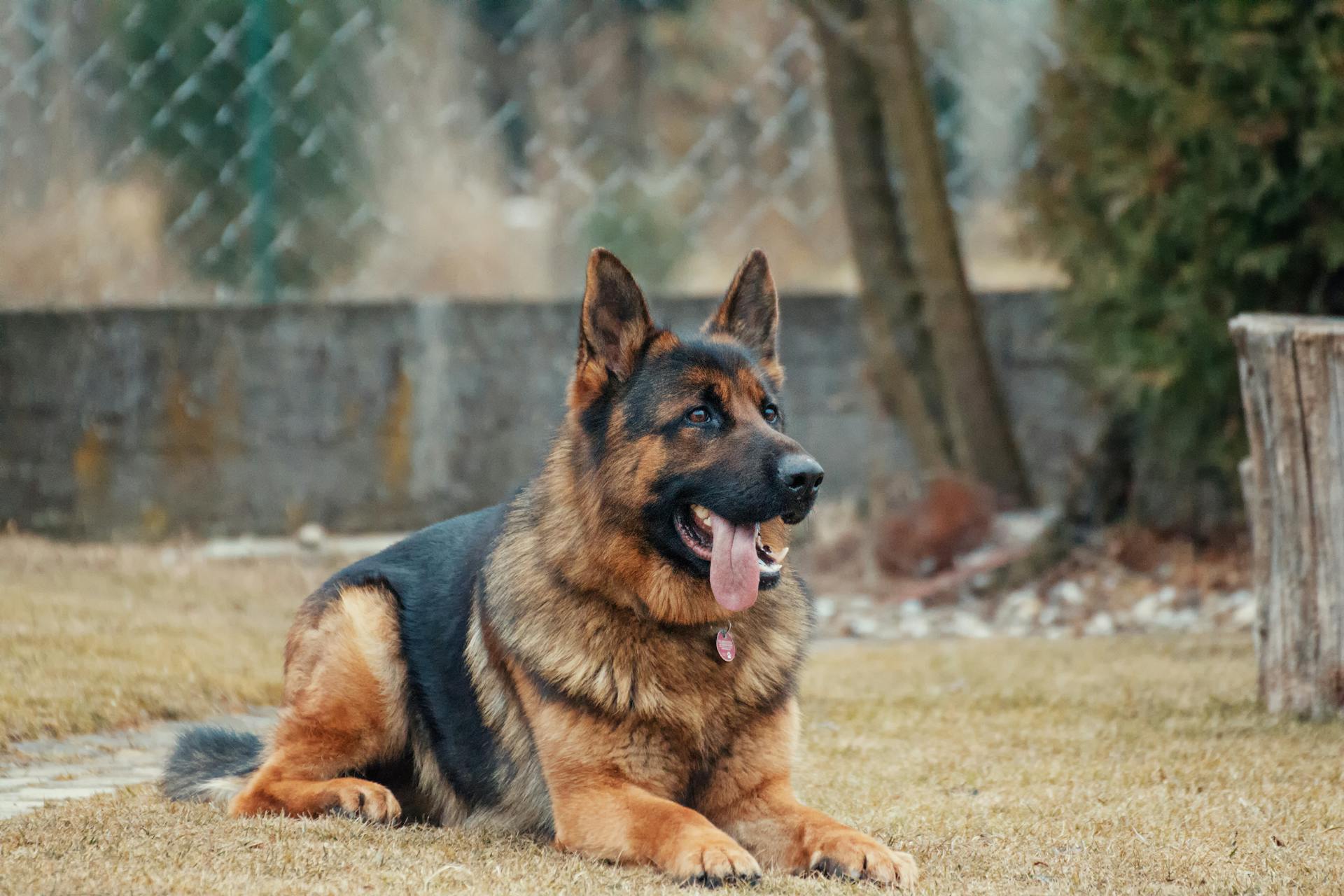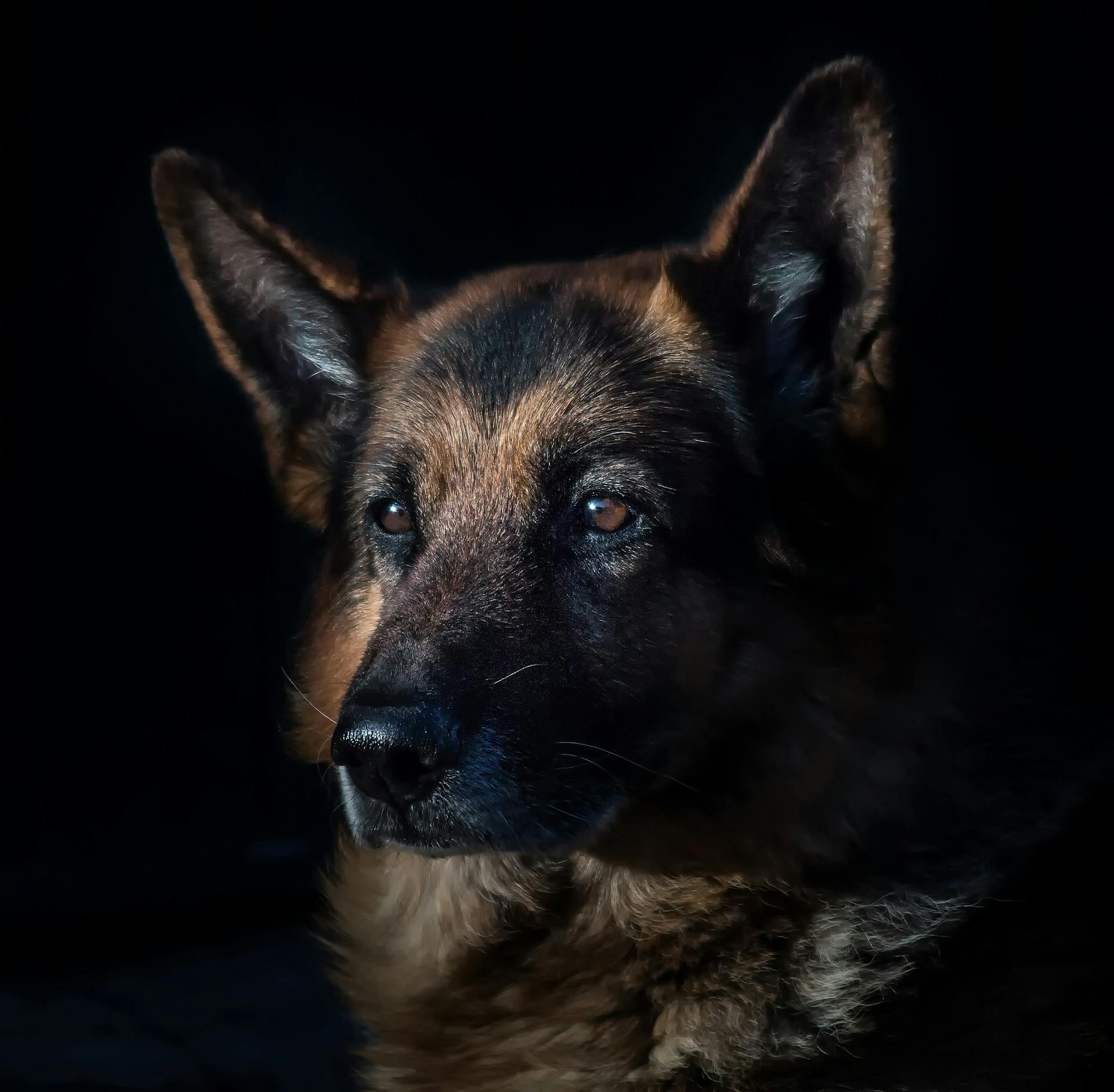
German Shepherds have a striking resemblance to wolves, and it's not just a coincidence. Their physical features are a testament to their ancestry, with a shared history that dates back thousands of years.
Their thick double coats, for instance, are a direct result of their wolf-like predecessors. German Shepherds have a two-layer coat, with a soft undercoat and a coarse outer layer, similar to the wolf's double coat.
Their sharp teeth and powerful jaws are also a characteristic they inherited from wolves. German Shepherds have a unique dental structure, with a curved canine tooth and a distinctive jaw shape, similar to that of a wolf.
Their eyes, too, are a giveaway of their wolf-like heritage. German Shepherds have an almond-shaped eye, similar to the wolf's, which gives them exceptional peripheral vision and depth perception.
History and Origins
German Shepherds have a unique appearance that's often compared to wolves, but what's behind this similarity? Recent research shows that domesticated dogs, including German Shepherds, are more like long-lost cousins of wolves rather than direct descendants.
Domesticated dogs share much of the same DNA as wolves, which is why they can mate and produce fertile wolf hybrids. This genetic link is a result of an ancestor of the wolf being domesticated between 15,000 and 40,000 years ago.
The German Shepherd's resemblance to wolves is not a coincidence. In fact, researchers have found archeological evidence that the oldest dog fossils existed in what is now modern-day Germany. This discovery represents the first clear divergence of dogs from their early ancestors.
The emergence of the various breeds, including the German Shepherd, is a result of genetic drift. As populations of dogs became isolated from one another, the gene pool evolved, leading to different traits we see in the various breeds.
Related reading: How Many Breeds of German Shepherds Are There
Breed Characteristics
German Shepherds and wolves share many traits, including 78 chromosomes, which means they can interbreed and have viable offspring. They also communicate similarly with whimpers, barks, and howls.
Both German Shepherds and wolves have similar anatomy that equips them to be carnivores, but living with humans for 20,000-40,000 years has changed our pets, and today's dogs have a more diverse diet. However, German Shepherds have retained some of their ancient traits, such as a keen prey drive.
Some German Shepherds are more wolf-like than others, depending on their lineage and breeding history. Certain types of German Shepherds, such as the Show Line German Shepherds, have been selectively bred for changes in their coat lengths, coat types, weights, and lengths.
Czechoslovakian
The Czechoslovakian Wolfdog is a breed that's not for the faint of heart. They're a mix of German Shepherd and Carpathian wolf, with around 6% wolf and 94% German Shepherd.
This breed was created in the 1950s by the Czech military, with the goal of creating a blood-thirsty and vicious patrol dog. However, the result was a more cuddly and loving companion.
They're not officially recognized by the American Kennel Club yet, but they're gaining popularity as a companion for active families. They're also used in search and rescue, herding, agility, tracking, drafting, and working dog sports.
To keep a Czechoslovakian Wolfdog happy and healthy, you'll need to provide at least 2 to 3 hours of exercise a day. They're not for first-time dog owners, as they require a lot of attention and care.
They're known to be vigilant and suspicious of strangers, but they're also very loving to their family. This makes them a great companion for families who are willing to put in the hard work.
Expand your knowledge: Why Does My Dog Not like Me Sniffing Him?
German Shepherd
The German Shepherd is a well-known breed in the canine world and is the 3rd most popular dog breed in America. They have a standard coat and colors, but also come in rarer colors such as pure white, pure black, and blue.
Their wild-looking face and frame make them a popular choice for wolf crosses due to their trainability, human loyalty, and re-activating wolf genes. Some people say that the longer-haired German Shepherds look quite a bit like a wolf you'd find in the wild.
German Shepherds are an intensely energetic and intelligent breed that needs to be placed with a family that can spend a lot of time with them. They require plenty of toys and brain games to keep their smart brain stimulated.
Here are some key characteristics of the German Shepherd breed:
- Intensely energetic and intelligent
- Needs plenty of time and stimulation
- Can come in rarer colors such as pure white, pure black, and blue
- Has a wild-looking face and frame
Their ancestry and physical traits are similar to those of wolves, which is why they're often used in wolf crosses. They have 78 chromosomes, just like wolves and coyotes, which allows them to interbreed and have viable offspring.
Puppies
German Shepherd puppies are born weighing around half a pound to one pound, which is similar to gray wolf puppies.
As they grow, both German Shepherds and gray wolves gain weight and develop at a similar pace until they reach sexual maturity, which occurs between 1 to 2 years for German Shepherds and 2 to 3 years for gray wolves.
Their growth patterns diverge during adolescence, where German Shepherds may be smaller or similar in size to gray wolf puppies of the same age, who are around the same size as adult gray wolves.
Discover more: King Shepherd Weight
Physical Features
German Shepherds can look like wolves due to their size, but they're still dogs and should be treated as such.
Captain Max von Stephanitz, the founder of the German Shepherd Dog, was particularly fond of the wolf-like characteristics of a dog he saw in the late 1800s in western Germany.
Some German Shepherds, like the Show Line German Shepherds, have been selectively bred for changes in their coat lengths, weights, and muscularity, which can make them less wolf-like.
The initial German Shepherd, Horand von Grafrath, displayed wolf-like traits, but over time, some of those characteristics became less prominent as the breed was developed.
Ears
German Shepherds are very well known for their large, erect "bat-like" ears.
Their erect ears come from their wolf ancestry, and while they tend to have larger ears than most wolves, this trait is a defining physical characteristic of the breed.
Many dog breeds developed more "cute" traits to appeal to humans and ensure they received food and shelter, resulting in floppy ears.
Check this out: Birds Ears
Males

Male German Shepherds typically weigh between 65 to 90 pounds and stand 24 to 26 inches tall at the shoulder.
On average, a male gray wolf is significantly larger, weighing between 70 to 115 pounds and standing 26 to 32 inches tall at the shoulder.
Male German Shepherds are generally longer than they are tall, and the same goes for male gray wolves, which can reach a length of 4 ½ to 6 feet from nose to tail.
Individuals of both species can vary in size, with some being smaller or larger than average.
Saarloos Wolfdog
The Saarloos Wolfdog is a breed that's worth mentioning when discussing why German Shepherds look like wolves. It's a cross between a German Shepherd and a European wolf, and it's known for its wolf-like appearance.
They share a common ancestor, the gray wolf, which is the same species as the German Shepherd. This close genetic relationship makes it possible for them to interbreed and produce viable offspring.
The Saarloos Wolfdog is a result of this interbreeding, and it's often considered a wolf-dog hybrid. It's not a purebred wolf, but it does retain many of its wolf-like characteristics.
Here are some key traits that the Saarloos Wolfdog shares with wolves:
- Wolf-like appearance
- Similar anatomy, including 78 chromosomes
- Prey drive and carnivorous instincts
- Skittish and aggressive behavior
- Prone to escaping and requiring experienced care
These traits are not unique to the Saarloos Wolfdog, but they're all characteristics that are shared with wolves. It's no wonder that German Shepherds, which are closely related to wolves, also exhibit some of these traits.
Comparison and Facts
German Shepherds and wolves share many traits, including 78 chromosomes, which allows them to interbreed and have viable offspring. They also communicate similarly with whimpers, barks, and howls.
Their anatomy is also similar, equipping them to be carnivores, but living with humans for 20,000-40,000 years has changed our pets, making their diets more diverse.
German Shepherds have retained some of their ancient traits, including a keen prey drive, which is an asset for livestock protection dogs. They also have a low wanderlust potential, making sense for their role as herding animals.
Selective breeding took German Shepherds down a different path, but they still have instincts hardwired in their DNA that are more wolf-like than their history would indicate. German Shepherds were bred to retain wolf-like traits to deter predators of livestock.
The average gray wolf, which is the most common wolf species in North America, resembles the German Shepherd in physical traits. German Shepherds were bred to look like wolves due to their original function as working dogs that protected herds of sheep and other livestock.
Featured Images: pexels.com


